Duncan Greenlees ((1899–1966) an Englishman – a seeker, social activist, teacher and writer – spent many years in India. Writing about an episode from his stay at Sri Ramanasramam in the presence of Bhagavan Ramana Maharshi, he says:
“One day in the Hall I was browsing a notebook of extracts on yoga. Bhagavan hardly ever spoke to me first (indeed there was very little actual talking between us during the years; it did not seem necessary, somehow), but that day he spoke to me in English: “What is that book?”
I answered him.
He said quietly, “Read Milarepa”.
I read the book; it thrilled and stirred deep places in my heart. Somehow, I feel Bhagavan had seen that it would be so and therefore gave me the only order of the sort he had ever given me.”
We are at Zutulpuk (Zuthul Phuk) in the eastern valley of Kailasa.
Zuthul means “miracle” and “phuk” is ‘’cave”. This is the place of the miracle-cave of the great sage Milarepa…
What Bhagavan Ramana is to Arunachala, Milarepa is to Kailasa. And both are non-different. Milarepa was a supreme yogi who lived in the eleventh and twelfth century AD. As a realized sage, he stayed for many years in the vicinity of Mt Kailasa. Having attained the highest state of ‘Realization’, he was ‘One’ with the very consciousness that is Kailasa. Like Sri Ramana, Milarepa too used to be clad in a thin white cotton cloth. Indeed Mila-repa means Mila, the cotton clad …
A picture of Milarepa, from the Net
`
His body is depicted to be green in color because his staple food was nettles that grew in the mountains of Kailasa region…
Let us savor a few quotes from Milarepa.
Here is one – “When you run after your thoughts, you are like a dog chasing a stick. Every time a stick is thrown, you run after it. Instead, be like a lion who, rather than chasing after the stick, turns to face the thrower. One only throws a stick at a lion once.”
Here is a another – “In meditating on the Final Goal, one has to discover the non-existence of the personal Ego, and therefore the fallacy that it exists (i.e. because everything in the universe with name and form is basically illusory in nature)”
And one more… “I have understood this body of mine to be the product of ignorance, composed of flesh and blood and lit up by the perceptive power of consciousness. To those fortunate ones who long for emancipation it may be the great vessel by which they may procure Freedom. But to the unfortunates who only sin, it may be the guide to lower and miserable states of existence. This our life is the boundary mark whence one may take an upward or downward path. Our present time is a most precious time, wherein each of us must decide, in one way or other, for lasting good or lasting ill.”
May the Lord help us take the right decision!
Here is a picture of Zutulpuk Gompa from the front side…( Source )
`
Zutulpuk, the miracle-cave is at the back of the red building seen above.
Milarepa is said to have meditated in this cave.., Story goes that Milarepa decided the roof was too high and went outside and pressed it down with this foot, leaving a footprint. Back inside, he realized he’d pushed it too far, but pushed it back up with his hand so that it was just right. His hand print can be seen in the cave ceiling as can be the foot print on the roof, one understands.
Here are some more photographs.. Shows another view of the gompa, and the entrance to the monastery (Source this and this )
Click and browse.
`
Once in, here’s a picture of the main altar. The three idols are of Avalokiteshvara, Buddha, and Padmasambhava… ( Click here for source of picture )
`
And here is a picture of the miracle cave of Milarepa.. ( Click here for source)
Inside a glass case ( somewhere towards 1 O’clock position in the picture) is a statue of Milarepa
`
`
A low ceiling… Not sure if there is height enough for an adult to stand… Meditation cave….
Swami Pranavananda tells us that the Gompa also has a seven foot, four sides, stone beam – said to be the stick of Milarepa, and that pilgrims test their strength by lifting it up…
Milarepa was the disciple of Marpa, the translator, who visited India several times in dangerous circumstances, to learn philosophy and collect Indian treatises, which he then translated to Tibetan. And Marpa in turn was a disciple of Naropa, a great sage – a Kashmiri Pandit – who was the chancellor the great university at Nalanda. After Naropa’s times, the Nalanda university was destroyed by the invasion of Turks, led by Bakhtiyar Khilji, when thousands of monks were slaughtered and the great library there was completely burnt down. The Wikipedia entry on Bakhtiyar Khilji says : “The burning of the library continued for several months and smoke from the burning manuscripts hung for days like a dark pall over the low hills”
Naropa and Milarepa are intimately connected. The Tantric traditions of Tibetan Buddhism have their seeds here, and quite some of the knowledge that was in India, has flowed into Tibet, where there have been translated and preserved. It is a pity that much of the intelligentsia of modern British-molded India does not hold value to these ancient knowledge banks, nor even has a clue about them. Thankfully Tibet does. And we owe them for this.
But yes, well below all these reams of knowledge, the current of spirituality that flows in the hearts of common people in regions of India, Tibet, China are much the same, the spiritual connection is seamless. And Kailas-Manasorvar is in Tibet-China, after all.
Let us now come back to Soota and his yatra.
The night at Zutulpuk was lost in deep slumber. It had been established by a reccie that the toilet facility was best avoided. So the next morning saw Soota and others head for the rocks in this hill behind. That done, the day began with one and all getting ready for the last leg of the Kora. The journey back to Darchen. We shall be trekking just about 8 or 10 kms today. The landscape we pass is wondrous.
Here is a magnificent view of the Eastern valley that we shall traverse ( Source )
`
And now let’s take a picture tour…
Click and browse.
`
- Starting off
- Horse trail
- Team that enabled Soota do the kora – Kedhor the horseman and his mare and foal
`
Soota’s mare had her foal tagging along. So riding that mare was fraught with surprises, as the foal would scamper away somewhere, and the mare decide to leave the trail to fetch the foal.. Or the foal deciding to cuddle under the mare’s belly and the mare reciprocating the love, with the rider getting tossed about….
But all in all, a beautiful stretch of nature….
Of this leg of the Parikrama, Lama Govinda writes : “So, on his way round the holy mountain , the pilgrim is constantly reminded of Milarepa when passing by luxuriantly growing patches of nettles . And many a pilgrim will sing one of Milarep a’s songs, popular all over Tibet, in praise of the solitudes and the life of renunciation, or in praise of the Buddha and his Guru, Marpa, The Translator.
And thus the pilgrim passes through the last part of the Eastern Valley which is like a fairyland of colours. Some of the rocks are flaming red, others dark blue and green, and next to them vivid orange and light yellow ones. It is as if, before leaving Kailas, the pilgrim were presented with samples of all the varieties of coloured rocks which he admired during the Parikrama.”
Here are a couple of pictures of the many hued hills ( source this and this )
Click to see a large view .
`
Continuing the walk with Lama Govinda:
“Finally, he emerges from the valley into the open plains until he reaches again the starting-point of the Parikrama, at the little monastery of Tarchen. While passing numerous mani-walls, composed of thousands of stones upon which pious devotees have carved the mantra Om mani padme Hum, in praise of the Buddha Avalokitesvara, who is the Jewel (maNi) which should reside in the Lotus (padma) of the devotee’s heart, the pilgrim adds his own stones in gratitude for what this pilgrimage has given to him, and as a blessing to the pilgrims who will come after him: ‘Sukhe Bhavantu!'(May they be happy! )”
`
`
And now, video time…..Sharing a three-bits-spliced-together video clip of the third day. Listen to the Zhong chu flow… Listen to the jingle of horse-bells… Come join the last leg of the kora!
`
`
The river that we see in the video is Zhong Chhu.
Swami Pranavananda writes: “Tibetans compare the Holy Kailas with the sahasrara chakra (the thousand petalled Psychic centre in the head) and the three rivers-Lha chhu, Zhong chhu, and the Tarchhen chhu- to the Kengma, the Rengma, and the Uma, which are the Ida, Pingala, and the Sushumna respectively of the yoga shastra. Tarchhen chu joins the Zhong chhu ; the Kerleb chhu joins the Lha chhu; further on the Zhong chhu debouches into the Lha chhu, which in turn debouches into Rakshas TaI; Dam chhu separately debouches into the Rakshas Tal. So all the rivers of Kailas fall into the Rakshas”
Here is a view of the Rakshas Tal from somewhere near our endpoint of Kora. And behind it, rising gloriously, is the snow clad Gurla Mandhata mountain…
`
`
Sometime in the forenoon, we reach the pickup point where buses wait for us. In time, all the co-yatri-s arrive. Everyone is in a state of daze. The Kora is complete. Or is it? How could it be? Have I really done it? Who am I?
The buses take off and bring us back to the guest house at Darchen. There, several co-yatri-s who had opted to stay back are waiting for us. They greet us with great warmth… Every one is on drained out batteries and yet on maximum joy mode…
After lunch, the group shall leave Darchen, and head back for Manasarovar.
Yes, “sarve janaah sukhino bhavantu! lokaah samastaah sukhino bhavantu” – may all people, all worlds, be happy!
** To be continued **
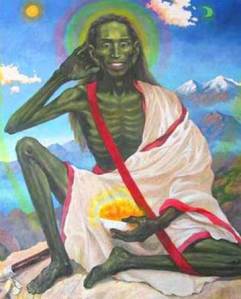
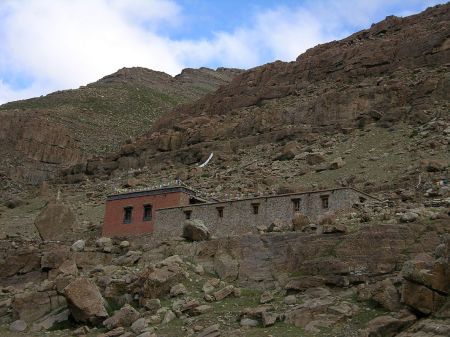



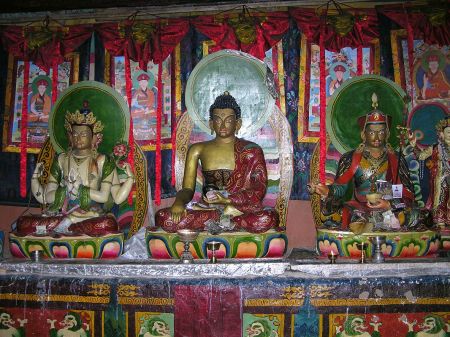
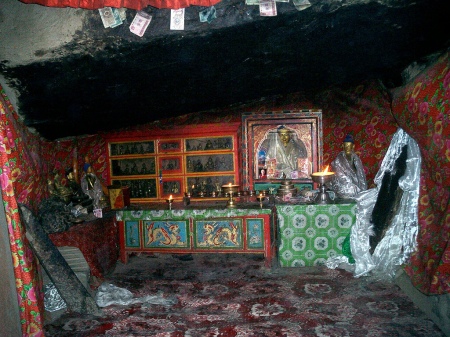
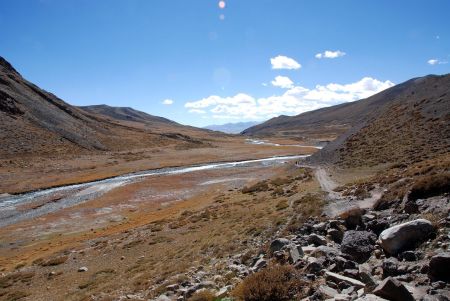
















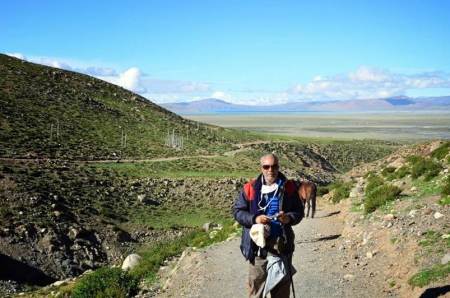
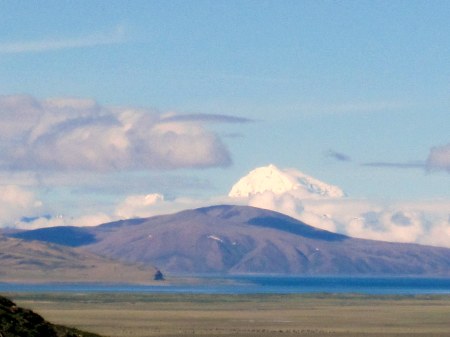

You must be logged in to post a comment.